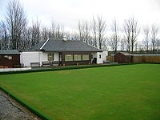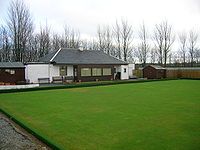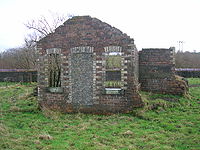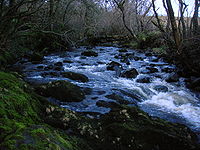
Glengarnock
Encyclopedia
Glengarnock is a small village in North Ayrshire
that lies near the west coast of Scotland
. It forms part of the Garnock Valley
area and is approximately 25 miles away for Glasgow
, the nearest city. The River Garnock
flows through the village, but the name Glen Garnock applies more specifically to the ravine at Glengarnock Castle
, some 4 kilometres (2.5 mi) to the north of the village.
, industrial estate and business park, amateur boxing club, primary school, church, YMCA and church hall hosting various groups, hairdresser, public house, medical health centre, pharmacy, post office, bait/cycle shop and convenience stores. Aside from this, the local towns of Kilbirnie
, Beith
and Dalry provide other amenities including supermarkets, swimming pool, fitness centre, dentists, opticians and libraries.
One of the first Libraries in North Ayrshire was formed by Mr William Rabey who formed a Reading room at the Steel Works.

 The main employment in the village came, historically, from the steelworks which existed on the shores of nearby Kilbirnie Loch
The main employment in the village came, historically, from the steelworks which existed on the shores of nearby Kilbirnie Loch
. This, however, has been closed and the site is now home to various small businesses. During the course of its life, the Iron Works there were owned by Colvilles, Merry and Cunningham and British Steel, finally closing in the early eighties. In 1890 Merry and Cunninghame's interest in Glengarnock had finished and Glengarnock Iron and Steele was formed. From 1900 to 1914 there were periods of trade depression and when war was declared in 1914 the plant was idle. The ministry of Munitions instructed them to produce munition for the war. David Colville purchased the Plant in 1916. Perhaps the 1930s was the first time people started to leave, Economic Depression and the Means test which had been newly introduced left a lot of people poor so they moved in the hope of lives elsewhere. Riots were breaking out at that time. In 1978 they employed just 200 people. Staff magazines from the entire period have been preserved and are held by the Mitchell reference Library in Glasgow. This throws an interesting light in the period. Ironically some of the buildings of the old steel works still lie empty on the site and one of them even has the Steel work War Memorial still on the wall with names of the fallen during the two great wars, who were employees of the Steel works.
Various industries and businesses are situated today at the Lochshore Industrial Estate and Glengarnock Business Park in Caledonian Road, and in the village itself.
 The River Garnock
The River Garnock
runs through the village. It flows from the base of the Hill of Stake in a southery direction, traversing Kilbirnie and Glengarnock, and making its way to Irvine Harbour where it enters the sea. The source of the River Garnock is in the Muirsheil Hills and is known as "Jacobs Well".
Kilbirnie Loch
is situated nearby, however the River Garnock does not flow into it, although in the past it has been known to flood into it.
Originally schooling was carried out in wooden huts near the Caledonian Railway Line "the caley" a line long since closed. In 1830 there were 230 children on the roll. In 1870 Robert Grey took over and the "grey School" (Glengarnock Primary) was built in 1877 then the top part of it built in 1903 (demolished in 1992). The colour of the place was also Grey which also helped for it to earn this nickname.
The new Glengarnock Primary school was opened in 1992. The new school has a capacity for 330 pupils. For secondary education pupils will go to Garnock Academy in Kilbirnie.

 Glengarnock Church has now been closed and demolished although the Manse remains as a private residence. A memorial to the Church in the form of the preserved steeple has been erected in the village main street. It was formed in 1870 composed of people from Kilbirnie Beith Dalry and of course the local folk. It was original United Presbyterian
Glengarnock Church has now been closed and demolished although the Manse remains as a private residence. A memorial to the Church in the form of the preserved steeple has been erected in the village main street. It was formed in 1870 composed of people from Kilbirnie Beith Dalry and of course the local folk. It was original United Presbyterian
becoming United Free
and eventually Glengarnock Parish Church. When it closed a time capsule was dug up, containing items of the time. It is held by the Auld Kirk
of Kilbirnie.
Glengarnock also has a Jehovah's Witness meeting room as well as the "Hebron Hall" Plymouth Brethren assembly.
The Hebron Hall Plymouth Brethren Assembly was opened in 1921. Previously "Duffield's Building" had been used, a building across from the old Glengarnock School. Then as the Assembly was formed, they met in the Orange Lodge Hall before the present hall.
North Ayrshire
North Ayrshire is one of 32 council areas in Scotland with a population of roughly 136,000 people. It is located in the south-west region of Scotland, and borders the areas of Inverclyde to the north, Renfrewshire to the north-east and East Ayrshire and South Ayrshire to the East and South...
that lies near the west coast of Scotland
Scotland
Scotland is a country that is part of the United Kingdom. Occupying the northern third of the island of Great Britain, it shares a border with England to the south and is bounded by the North Sea to the east, the Atlantic Ocean to the north and west, and the North Channel and Irish Sea to the...
. It forms part of the Garnock Valley
Garnock Valley
The Garnock Valley is an area in the northern part of North Ayrshire, Scotland, adjoining Renfrewshire.The region includes the towns of Beith, Dalry, and Kilbirnie, and some smaller villages such as Gateside, Barrmill, Longbar and Glengarnock....
area and is approximately 25 miles away for Glasgow
Glasgow
Glasgow is the largest city in Scotland and third most populous in the United Kingdom. The city is situated on the River Clyde in the country's west central lowlands...
, the nearest city. The River Garnock
River Garnock
The River Garnock, the smallest of Ayrshire's six principal rivers, has its source on the southerly side of the Hill of Stake in the heart of the Clyde Muirshiel Regional Park. About a mile and a half south of this starting point the untested stream tumbles over the Spout of Garnock, the highest...
flows through the village, but the name Glen Garnock applies more specifically to the ravine at Glengarnock Castle
Glengarnock Castle
Glengarnock Castle is one of the ancient ruined fortifications of Ayrshire. Its keep is located on a remote rocky promontory overlooking the River Garnock about north of the town of Kilbirnie in North Ayrshire, Scotland. There is no clear account of when this was erected or by whom, but it may...
, some 4 kilometres (2.5 mi) to the north of the village.
Amenities
The village's main features are Glengarnock railway stationGlengarnock railway station
Glengarnock railway station is a railway station in the village of Glengarnock, North Ayrshire, Scotland, serving the towns of Beith and Kilbirnie...
, industrial estate and business park, amateur boxing club, primary school, church, YMCA and church hall hosting various groups, hairdresser, public house, medical health centre, pharmacy, post office, bait/cycle shop and convenience stores. Aside from this, the local towns of Kilbirnie
Kilbirnie
Kilbirnie is a small town of 7280 inhabitants situated in North Ayrshire on the west coast of Scotland...
, Beith
Beith
Beith is a small town situated in the Garnock Valley in North Ayrshire, Scotland approximately 20-miles south-west of Glasgow. The town is situated on the crest of a hill and was known originally as the "Hill o' Beith" after its Court Hill.-History:-Name:Beith's name is thought to emanate from...
and Dalry provide other amenities including supermarkets, swimming pool, fitness centre, dentists, opticians and libraries.
Social History
The history of Glengarnock is a rather tragic one, it grew up around the Steel works which, even before 1840 had a presence on the site. Once closed in the eighties, Glengarnock almost died, now having a small fraction of the population which once existed. On looking at the town now, a stranger would assume Glengarnock was a suburb of Beith or Kilbirnie but the truth is it had a large population and a very thriving community at one stage.One of the first Libraries in North Ayrshire was formed by Mr William Rabey who formed a Reading room at the Steel Works.
Industry


Kilbirnie Loch
Kilbirnie Loch , is situated in the floodplain of between Kilbirnie, Glengarnock and Beith, and runs south-west to north-east for almost , is about wide for the most part and has an area of roughly 3 km2 . It has a general depth of around 5.2 metres to a maximum of around 11 metres...
. This, however, has been closed and the site is now home to various small businesses. During the course of its life, the Iron Works there were owned by Colvilles, Merry and Cunningham and British Steel, finally closing in the early eighties. In 1890 Merry and Cunninghame's interest in Glengarnock had finished and Glengarnock Iron and Steele was formed. From 1900 to 1914 there were periods of trade depression and when war was declared in 1914 the plant was idle. The ministry of Munitions instructed them to produce munition for the war. David Colville purchased the Plant in 1916. Perhaps the 1930s was the first time people started to leave, Economic Depression and the Means test which had been newly introduced left a lot of people poor so they moved in the hope of lives elsewhere. Riots were breaking out at that time. In 1978 they employed just 200 people. Staff magazines from the entire period have been preserved and are held by the Mitchell reference Library in Glasgow. This throws an interesting light in the period. Ironically some of the buildings of the old steel works still lie empty on the site and one of them even has the Steel work War Memorial still on the wall with names of the fallen during the two great wars, who were employees of the Steel works.
Various industries and businesses are situated today at the Lochshore Industrial Estate and Glengarnock Business Park in Caledonian Road, and in the village itself.
Housing
At one stage the village was highly populated with a number of "rows", small houses built for employees of the steel works and miners. These have all since been demolished. The only thing which remains of the old village are the houses in the Main Street and "Longbar", a local council housing estate now partially demolished. The name comes from the name "lambert" which existed close by.Co-op Buildings
The original building had a number of shops, grocer, shoe cobbler dairy and butcher. The bottom part of it is now a Jehovah's Witness meeting place and above are various flats.The River Garnock and Kilbirnie Loch

River Garnock
The River Garnock, the smallest of Ayrshire's six principal rivers, has its source on the southerly side of the Hill of Stake in the heart of the Clyde Muirshiel Regional Park. About a mile and a half south of this starting point the untested stream tumbles over the Spout of Garnock, the highest...
runs through the village. It flows from the base of the Hill of Stake in a southery direction, traversing Kilbirnie and Glengarnock, and making its way to Irvine Harbour where it enters the sea. The source of the River Garnock is in the Muirsheil Hills and is known as "Jacobs Well".
Kilbirnie Loch
Kilbirnie Loch
Kilbirnie Loch , is situated in the floodplain of between Kilbirnie, Glengarnock and Beith, and runs south-west to north-east for almost , is about wide for the most part and has an area of roughly 3 km2 . It has a general depth of around 5.2 metres to a maximum of around 11 metres...
is situated nearby, however the River Garnock does not flow into it, although in the past it has been known to flood into it.
School
The town has a local primary school with around 200 children. The bulk of Children coming from Kilbirnie.Originally schooling was carried out in wooden huts near the Caledonian Railway Line "the caley" a line long since closed. In 1830 there were 230 children on the roll. In 1870 Robert Grey took over and the "grey School" (Glengarnock Primary) was built in 1877 then the top part of it built in 1903 (demolished in 1992). The colour of the place was also Grey which also helped for it to earn this nickname.
The new Glengarnock Primary school was opened in 1992. The new school has a capacity for 330 pupils. For secondary education pupils will go to Garnock Academy in Kilbirnie.
Religion


United Presbyterian Church of Scotland
The United Presbyterian Church of Scotland was a Scottish Presbyterian denomination. It was formed in 1847 by the union of the United Secession Church and the Relief Church, and in 1900 merged with the Free Church of Scotland to form the United Free Church of Scotland, which in turn united with...
becoming United Free
United Free Church of Scotland
The United Free Church of Scotland is a Scottish Presbyterian denomination formed in 1900 by the union of the United Presbyterian Church of Scotland and the Free Church of Scotland...
and eventually Glengarnock Parish Church. When it closed a time capsule was dug up, containing items of the time. It is held by the Auld Kirk
Kilbirnie Auld Kirk
Kilbirnie Auld Kirk is a Church of Scotland congregation on Dalry Road , Kilbirnie, North Ayrshire, Scotland. Although the building dates back to the 15th century, the present congregation was formed in 1978 by the amalgamation of Glengarnock Parish Church and the The Barony Church.- History...
of Kilbirnie.
Glengarnock also has a Jehovah's Witness meeting room as well as the "Hebron Hall" Plymouth Brethren assembly.
The Hebron Hall Plymouth Brethren Assembly was opened in 1921. Previously "Duffield's Building" had been used, a building across from the old Glengarnock School. Then as the Assembly was formed, they met in the Orange Lodge Hall before the present hall.
Sports & Pastimes
- Glengarnock Ironworks Bowling Club
- Garnock Rugby Football Club
- Garnock Choral Society
- Garnock Burns Club
- Kyle Water Ski Club
- Trout Fishing

